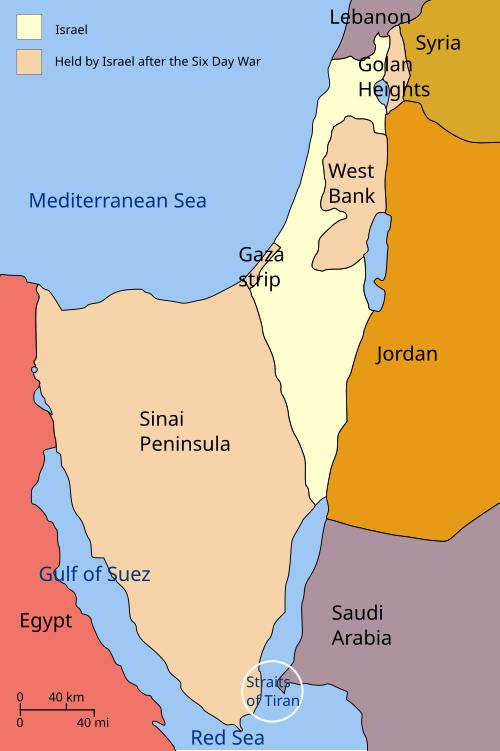IB Syllabus focus:
'Analyze the various Arab–Israeli conflicts, including the Suez Crisis, Six Day War, and the 1973 War.
Explore the effects of these conflicts, such as occupied territories, intifadas, and the role of the Palestine Liberation Organization (PLO).'
The Arab–Israeli conflicts were pivotal in shaping the geopolitical fabric of the Middle East. Spanning from the mid-20th century, these conflicts have had profound implications on the regional and international stage, affecting political borders, economies, and the daily lives of millions.
Suez Crisis (1956)
Background
Strategic Importance: The Suez Canal was a critical maritime route for international trade, especially for European colonial powers.
Nationalisation: On 26 July 1956, President Nasser announced the nationalisation of the Suez Canal, previously owned by the Suez Canal Company, which was under British and French control.
Motivations: This move was partly a response to the withdrawal of the US and British offer to fund the Aswan Dam, a symbol of Egyptian modernisation.
Military Actions
Tripartite Aggression: The invasion, known in the Arab world as the Tripartite Aggression, involved coordinated attacks by Israel, followed by British and French forces.
Israeli Military Objectives: Israel aimed to reopen the Straits of Tiran for Israeli shipping and to push back against fedayeen guerrilla attacks emanating from the Sinai.
Effects
United Nations Intervention: The crisis marked the first time the United Nations Peacekeeping forces were used to maintain a truce between conflicting parties.

UN Emergency Force (UNEF I) troops patrol the Sinai frontier in early 1957, following the withdrawal of Israeli, British, and French forces. As the UN’s first peacekeeping mission, UNEF monitored ceasefire lines and helped stabilize the armistice—an institutional innovation born of the Suez Crisis. Source
Shift in Power: The crisis diminished the status of Britain and France as world powers, signalling the rise of American and Soviet influence in the region.
Pan-Arabism: Nasser's stance made him an icon of Pan-Arabism, and the crisis proved a catalyst for decolonisation across Africa and Asia.
Six Day War (1967)
Causes
Immediate Causes: The blockading of the Straits of Tiran by Egypt and the signing of mutual defence pacts among Arab states were immediate causes of the war.
Intelligence Misinterpretation: Israeli intelligence misread Arab troop movements as preparations for an imminent attack, prompting a pre-emptive strike.
Course of the War
Air Superiority: Israel's opening attack destroyed the majority of the Egyptian Air Force on the ground, ensuring air superiority.
Rapid Ground Assaults: Israeli forces quickly overwhelmed Arab armies, dramatically reshaping the map of the Middle East in six days.
Consequences
Occupation: The war resulted in Israel occupying the Sinai Peninsula, the Gaza Strip, the West Bank, East Jerusalem, and the Golan Heights.

Israel’s territorial gains after June 1967 included the Sinai Peninsula (from Egypt), the Gaza Strip, the West Bank and East Jerusalem (from Jordan), and the Golan Heights (from Syria). The map provides a concise geographic overview that aligns with the outcomes described in UN Security Council Resolution 242. Source
UN Resolution 242: This resolution called for the "withdrawal of Israeli armed forces from territories occupied in the recent conflict" and "the termination of all claims or states of belligerency".
1973 War (Yom Kippur War)
Overview
Surprise Attack: The war began with a coordinated attack by Egypt and Syria during the Jewish holiday of Yom Kippur on 6 October 1973.
Egyptian Crossing of the Suez: Egyptian forces crossed the Suez Canal and established a bridgehead on the east bank before the Israeli counter-attack.

Egyptian military trucks cross a pontoon bridge over the Suez Canal on 7 October 1973 during the Yom Kippur War, illustrating the initial Egyptian success in seizing and holding east-bank bridgeheads. The crossing neutralized parts of the Bar-Lev Line and shifted early battlefield momentum before Israeli counter-operations. Source
Turning Point and Outcome
Golan Heights Battles: Syrian forces initially made gains in the Golan Heights before being repelled by the Israelis.
Military Stalemate: Although both Egypt and Syria achieved initial successes, the conflict eventually reached a military stalemate.
Aftermath
Psychological Impact: The war had a significant psychological impact on the Israeli public, leading to a reassessment of Israel’s strategic vulnerabilities.
Peace Process: It ultimately led to the Israeli-Egyptian peace talks and the signing of the Camp David Accords.
Occupied Territories
The Sinai Peninsula
Repeated Conflicts: The Sinai was the site of repeated conflicts between Israel and Egypt until its return to Egypt in 1982.
Demilitarisation: As part of the peace agreement, the Sinai was demilitarised and monitored by international peacekeepers.
The West Bank and Gaza
Military Administration: Israel established a military administration in these territories, controlling many aspects of daily life.
Palestinian Resistance: The territories became a focal point for Palestinian nationalism and resistance against Israeli control.
The Golan Heights
Annexation and Settlement: Israel extended its laws to the Golan Heights, an action condemned by the United Nations Security Council.
Intifadas
The First Intifada (1987-1993)
Civil Unrest: The Intifada began in the Jabalia refugee camp and quickly spread, characterised by widespread demonstrations and civil unrest.
Israeli Military Response: The Israeli Defence Forces (IDF) employed various measures to control the uprising, leading to significant casualties.
Political Change: The Intifada led to the 1991 Madrid Peace Conference, which created a new framework for Middle East peace talks.
The Second Intifada (2000-2005)
Ariel Sharon’s Visit: The visit was seen as a provocative act by Palestinians, leading to violent outbreaks.
Increased Casualties: This period saw significant loss of life on both sides, including numerous suicide bombings and military operations.
Security Barrier: Israel began constructing a security barrier in the West Bank during this period, which it claimed was necessary for security reasons but was seen by Palestinians as an illegal land grab.
Role of the Palestine Liberation Organization (PLO)
Foundation and Ideology
Charter Goals: The PLO’s original charter called for the "liberation of Palestine" and the establishment of a democratic state for Muslims, Christians, and Jews in Palestine.
Guerrilla Warfare: The PLO engaged in guerrilla warfare against Israeli targets and was involved in the Lebanese Civil War.
Actions and International Relations
Black September: The PLO was expelled from Jordan following the Black September conflict and later from Lebanon after the Israeli invasion in 1982.
International Standing: Despite its militant origins, the PLO gained observer status at the United Nations and was recognised by many countries as the legitimate representative of the Palestinian people.
Shift towards Diplomacy
Oslo Accords: The PLO engaged in secret negotiations that led to mutual recognition between the PLO and Israel.
Palestinian Authority: The accords established the Palestinian Authority as an interim self-government body to govern parts of the West Bank and Gaza.
These detailed study notes encompass the pivotal moments and their subsequent effects during the Arab–Israeli conflicts, highlighting the complexity of the relationships and the enduring quest for peace and security in the Middle East.
FAQ
The Camp David Accords had a profound impact on Middle Eastern politics. The peace agreement, signed by Egyptian President Anwar Sadat and Israeli Prime Minister Menachem Begin under the auspices of US President Jimmy Carter in 1978, marked the first time an Arab country recognised Israel. This led to the normalisation of relations between Egypt and Israel and Egypt's regaining of the Sinai Peninsula. However, the Accords isolated Egypt within the Arab world, leading to its suspension from the Arab League until 1989. This peace treaty created a precedent for future Arab-Israeli negotiations but also exposed the complexities of achieving comprehensive regional peace, as it did not address Palestinian aspirations for statehood and sovereignty.
Israel's territorial gains following the Six Day War were met with international controversy and diplomatic challenges. The United Nations Security Council adopted Resolution 242, which became a reference point for future peace negotiations, calling for Israeli withdrawal from occupied territories in exchange for peace and mutual recognition. The Arab world, initially in shock, unified in the Khartoum Resolution with the famous "Three No's": no peace with Israel, no recognition of Israel, no negotiations with Israel. Internationally, there was a split; non-aligned and Soviet bloc countries mostly supported the Arab stance, while Western opinions varied, with some seeing Israel as defending itself and others criticising its expansion.
The international community's response to Israeli occupation after the 1973 War was marked by a renewed push for a diplomatic resolution. The United Nations passed several resolutions calling for Israel to withdraw from occupied territories and reaffirming the right of all states in the area to live in peace. The US, under the leadership of Secretary of State Henry Kissinger, pursued a policy of shuttle diplomacy to ease tensions and negotiate disengagement agreements between Israel, Egypt, and Syria. Despite these efforts, the occupation continued to be a source of international debate and contention, with numerous countries criticising Israel for settlements in occupied territories, deemed illegal under international law, and for not adhering to UN resolutions.
The Suez Crisis strained the relationship between the United States and its European allies, notably Britain and France. The US was not consulted before the tripartite invasion and opposed the military action, pressuring the invading forces to withdraw through a combination of diplomatic isolation and financial mechanisms, such as imposing economic sanctions. This intervention highlighted the declining European influence and the ascendancy of American power in the region, leading to resentment among the British and French governments. The crisis underscored the necessity of the European powers to consider American positions in their foreign policies, significantly altering the dynamics of the Western alliance during the Cold War.
The Six Day War erupted due to a combination of interrelated factors. The immediate causes included the Egyptian blockade of the Straits of Tiran, which was a vital shipping lane for Israeli trade, particularly for the transport of oil. Additionally, the mobilisation of Egyptian forces in the Sinai Peninsula, along with the expulsion of UN peacekeeping forces, escalated tensions and fears of an impending Arab attack. The mutual defence pacts among Arab states and inflammatory rhetoric promising the destruction of Israel further intensified the situation. Lastly, the Soviet Union's provision of incorrect intelligence to Syria and Egypt about Israeli troop movements played a critical role in stoking fears and miscalculations that led to war.
Practice Questions
The Suez Crisis was undoubtedly a pivotal juncture in Middle Eastern history, marking the definitive end of British and French colonial influence in the region. The successful nationalisation of the Suez Canal by President Nasser of Egypt symbolised the rise of nationalist movements that were soon to reshape the political landscape of the Middle East. This incident not only elevated Nasser as a symbol of Arab resistance against Western dominance but also showcased the increasing superpower influence, particularly of the USA and USSR, in regional affairs. The crisis also triggered a shift in global maritime trade patterns and signalled the beginning of decolonisation across the Third World, profoundly influencing subsequent regional politics and the dynamics of the Cold War.
While the Six Day War of 1967 established new boundaries and dramatically shifted the territorial status quo, the 1973 War had more profound long-term political effects. It shattered the aura of invincibility that Israel had gained post-1967, significantly changing the regional power dynamic and mindset, which facilitated the subsequent peace process. The 1973 War led directly to the Camp David Accords, resulting in the first signed agreement between Israel and an Arab country, Egypt. It also had significant superpower involvement, with both the US and USSR airlifting supplies to their respective allies, which underscored the Cold War dimension of Middle Eastern politics. The psychological and political changes initiated by the Yom Kippur War hence set the stage for a more lasting impact on the geopolitical landscape of the Middle East.

